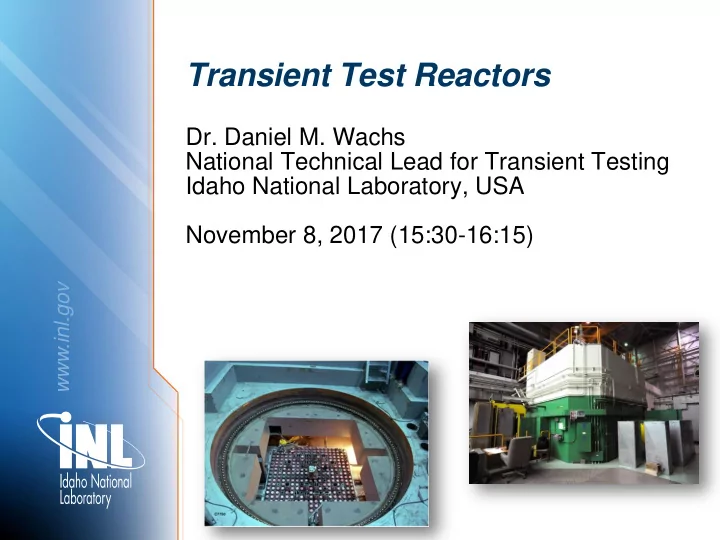

Transient Test Reactors Dr. Daniel M. Wachs National Technical Lead for Transient Testing Idaho National Laboratory, USA November 8, 2017 (15:30-16:15) www.inl.gov
Why do we need Transient Reactors? • Nuclear reactors are a complex multi-physics problem – Nuclear feedback mechanisms (coupled to thermal and mechanical response) are critical to enable reactor control and to maintain safe operations – All analysis codes must be benchmarked against representative experimental data • The performance limits of engineered reactor systems must be demonstrated to receive an operating license – Used extensively to qualify current LWR systems (and ongoing optimization) – Research and development of advanced systems 2
Transient Nuclear Physics • Annular Core Research Reactor (ACRR) at Sandia National Laboratory – https://www.youtube.com/watch?v=pa0Fmcv83nw – Transient response • Large reactivity insertion (rod ejection) • Very strong negative temperature feedback coefficient that rapidly reduces reactor power • Short power pulse (~10 ’s of ms) • Special Purpose Experimental Reactor Test (SPERT) at Idaho National Laboratory – https://www.youtube.com/watch?v=0FIhafVX_6I – Transient response • Large reactivity insertion (rod ejection) • Fairly strong negative temperature feedback coefficient that rapidly reduces reactor power (just not fast enough) • Short power pulse (~10 ’s of ms) 3
Fuel Performance and Safety Limits Overpower Control Rod Core Ejection Xe Burnout Misload Power Steady State Ramp Operation SCRAM HCDA Large Blockage Pump w/o SCRAM Coast-down Large Blockage (Element Damage) Power Reduction Large Break LOCA Small Blockage Small Break (Debris) LOCA Under-cooling ∞ µ s ms sec min hr hr min sec ms ∞ ~0 1 τ event TREAT Power/Cooling Ratio ATR Hot-cell PALM
Fuel Safety Research • To receive a design or operating license for a nuclear reactor the licensee must describe the off-normal performance of the system to define – Operating limits – Risk to the public • For design basis accidents including both overpower (reactivity initiated accident) and undercooling (loss of coolant accident) – Maintain coolable geometry (prevent propagation of failure) – Establish the related source term (and confirm its within regulatory limits) • Fraction of fuel failed (threshold for cladding rupture) • Radionuclide release (fraction of fission product retained) 5
Visualization of Fuel Behavior During RIA https://www.youtube.com/watch?v=h0o4P_F4s9s 6
Transient Test Results Fragmentation Threshold Failure Threshold 7
Fuel Safety Research Objectives Examples True Physical Limit Loss of Coolable Geometry Phenomenological Margin Existing Experimental Data “Fragmentation” of the Fuel = Simplified Physical Onset of Cladding damage, Limit Containment of fuel fragments Regulatory Margin Fuel Safety Criteria = 230 Cal/g energy deposition Design Margin Design Limit Calculated Design Conditions Operating Margin Operating Limit 8 Operating Conditions
Fuel Safety Science Objectives True Physical Limit New Test Data Phenomenological Phenomenological Margin Margin Simplified Physical Limit Regulatory Margin Fuel Safety Criteria Regulatory Margin Design Margin Design Limit Design Margin Operating Margin Operating Limit Operating Margin Operating Conditions $$$$ Operating Conditions 9
Transient Neutron Sources • Specialized reactors are required to deliver shaped neutron pulses to – Simulate off-normal conditions ranging from • Operational transients • Design basis accidents • Beyond design basis (severe) accidents – All without destroying the reactor! • Currently available test facilities include – CABRI (France) – recently refurbished – TREAT (USA) – to resume operations next week – NSRR (Japan) – IGR (Kazakhstan) 10
Transient Reactor Test (TREAT) Facility • TREAT’s unique design delivers the nuclear environment required to meet fuel safety research needs – 19 GW Peak Transient Power (with 100 kW Steady-state power option) – Core: ~1.2 m high x 2 m. dia19 x 19 array of 10 x 10-cm. fuel and reflector assemblies – Instantaneous, large negative temperature coefficient (self protecting driver core) • Resumption of Operations – ‘Mission Need Statement for Resumption of Transient Testing’ issued by DOE in January 2010 – TREAT Selected as ‘ preferred option’ in February 2014 and restart activities were initiated at the beginning of FY15 – Authorization to restart received in Sept 2017, First critical expected next week!
Transient Testing Capability Transient Testing Capability Demonstrated range of shaped transients TREAT can deliver In-pile instrumentation Experiment Vehicles that and PIE capabilities simulate environments ranging from simplified to prototypic
TREAT Transients Pulsing Continuous Power (e.g. ‘Flattop’) Power Ramps Complex Transients
Sample Environment • The irradiation test vehicle used in TREAT are cartridge type devices operated independently of the reactor. • These devices deliver the experiment specific thermal-hydraulic environment. Systems can be developed to deliver a wide range of conditions – Prototypic pressure/temperature/flow for LWR, SFR, LFR, GR or MSR applications – Specialized or simplified environments for separate effects studies • Program strategy will focus on development of modular devices that can be adapted for various user applications with minimal cost and schedule
Test Vehicles Insert Experiment Here Enlarged Instrument Penetration Flange Blowdown Valve Coolant lines Heaters Specimen & Flux Shaping Region Flow Meter Melt Catcher Region Expansion Tanks 15
– – 1 2 3 Sample Characterization n l • Pre- and Post-Test Examination been – Traditional PIE 1 3 – Modern 3D neutron tomography o • In-situ Instrumentation 2 – High speed, specialized instrumentation to Boiling Detector s 3D Reconstruction of 7-pin TREAT Test monitor temperature, pressure, deformation, etc. – Fast Neutron Hodoscope for real-time fuel motion monitoring TREAT Fast Neutron Hodoscope
How to access these facilities? • Joint International Projects – Fuel safety research is typically cross-cutting and of universal interest • Data shared between reactor designers, fuel vendors, utilities, and regulators (incentive to work together) – Limited number of transient test facilities (most nations don’t operate their own) – Examples include the • CABRI International Project (OECD NEA) • Halden Reactor Project (OECD NEA) • US Nuclear Science User Facility program (US Dept. of Energy) • Bilateral agreements between individual nations 17
Questions? 18
Recommend
More recommend